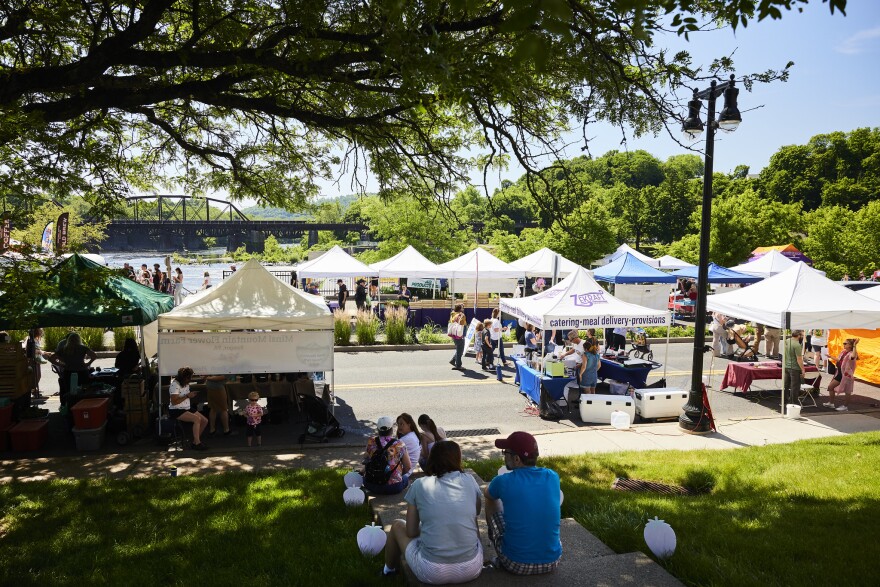BETHLEHEM, Pa. — It might be easier to food shop at a chain grocery store than a farmers market, but giving up convenience is worth it to get a better product, Megan McBride said.
“Just the nutritional value of the vegetables that you're buying at a farmers market versus the grocery store — it's night and day,” said McBride, director of Buy Fresh, Buy Local — a program of the Nurture Nature Center.
“Especially farmers that are doing regenerative agriculture, because those vegetables are soaking up so many more nutrients and vitamins, and are literally more nutritious.”
But, buying fresher, more nutritious food is only one of the benefits of shopping at local farmers markets, local officials argue.
With National Farmers Market Week ending Saturday, Aug. 9, market leaders highlighted several benefits from the 15 farmers markets across the Lehigh Valley, including adding to the local economy, driving tourism, supporting farmland preservation and strengthening community.
“It's just an amazing gathering space."Emily Roland, district manager of the Easton Farmers Market
“The reason that I love farmers markets so much is — I mean, there are so many different reasons — and I think the biggest being [that] this is such a fun and low-barrier way to interact with your community,” said Emily Roland, district manager of the Easton Farmers' Market.
“It's just an amazing gathering space. And, also, it's a way to just try something different that you might never have been able to try — depending on where you go, you're going to get a taste of something very local.”
‘Customers that come religiously’
Emmaus Farmers’ Market, held each Sunday at Triangle Park, has seen an uptick in customers this year, even with several weekends of unsettled weather, Jen Schuster, the market’s marketing and event coordinator, said.
“We had a couple rainy days, but we are open rain or shine, so that regardless of weather, we're there,” Schuster said.
“But this past weekend, a lot of people felt [it] was a record weekend, and we just kicked off National Farmers Market Week. Our customers in Emmaus, I think, are very unique as well, compared to other markets. We get customers that come religiously — every Sunday, they buy their fruits and vegetables.”

Generally, the market sees between 700 and 1,200 people on a Sunday, she said. The market has 30 vendors this season, selling produce, micro greens, honey, sourdough bread, pastries, olive oil, prepared meals and more.
“We're not the only ones doing this work,” Schuster said, noting the more than a dozen markets across the region.
“They're all operating in their own unique way, and trying out different things and supporting different vendors all across Lehigh Valley. It's really encouraging.”
Easton Farmers’ Market, a program of the Greater Easton Development Partnership, is the nation’s longest continuously operating open air market, and is in its 273rd season.
Open Saturdays on the riverfront at Scott Park, there’s an average of 50 vendors. While the emphasis is on seasonal produce, there are also beverages, prepared food and craft sellers.

“And then, we don't leave out our doggy friends, so we have dog treats,” Roland said.
“We try to check all the boxes — everything from like super fresh seasonal produce to pantry staples, like dried pastas and nut butters or frozen soup. We try to have a nice spread of everything.”
That variety is helpful to keep customers coming back, she said.
“We have lots of regular shoppers who come every week, and it's like their grocery store, and they show up with a wagon, and then they leave with a wagon full of food for the week,” she said.
“It helps just make that a consistent, one-stop-shop for folks to be able to get everything that they would want or need. Or, it's a way to get things that you would never find in the grocery store, too, super local items.”
Last Saturday was peach-themed, she said, and vendors showed off their creativity.
“We had just really, really fun peach combinations — everything from a peach gazpacho to a peach cobbler or a peach pasta,” Roland said.
“It's one thing to really lean into a theme and take it to the next level. But, it's especially exciting to see folks using local produce to make that happen.”
‘A pub crawl, but healthier’
During this season, Buy Fresh, Buy Local is continuing with its passport program, encouraging residents to visit as many local markets as possible and support farmers.
Described on the organization’s social media as “a pub crawl, but healthier,” participants collect stamps at each market. If they get all 15 by the end of the season in late October, they win a swag bag and get entered to win a $100 gift basket.
It’s one of the ways Buy Fresh, Buy Local is working to engage residents and municipal leaders, letting them know these markets exist, as well as the benefits of shopping local and supporting local markets.
“It's just really important for municipalities to understand the economic benefit in terms of helping to support food producers and farmers markets or farmers in their area, but then also the community benefit,” McBride said.
“And, the social benefit — how it brings people together and creates this amazing gathering space, which leads to so many things.”
Already, McBride estimates shoppers spend about $4 million at the Valley’s farmers markets over the course of a season. If more people shopped, it’d only increase.
But, supporting a local farmers market doesn’t have to be an all-or-nothing decision, she said.
“If [every person] just spen[t] $10 a week on local food, it adds $300 million to the Lehigh Valley economy,” she said. “It adds a tremendous amount to the local farm economy, and can make a big impact.”
Supporting farmers markets is also integral to farmland preservation.
“If you want to preserve farmland, you have to actually buy local food from farmers, because that's the other piece of farmland preservation. It's not just preserving that land, but it's helping to support those growers.”Megan McBride, director of Buy Fresh, Buy Local
“There is a connection there,” McBride said.
“If you want to preserve farmland, you have to actually buy local food from farmers, because that's the other piece of farmland preservation. It's not just preserving that land, but it's helping to support those growers.”
Balancing vendors, increasing diversity
Running a successful farmers market comes with its own set of unique challenges, from balancing the type and number of vendors, increasing convenience, to enticing younger customers.
“The biggest challenge for any market manager, 100% hands down, is trying to maintain that vendor balance,” McBride said.
“You want your vendors to be able to thrive and prosper at your market. And if you go over that tipping point and you have too many vendors in a specific category, it will create a lot of conflict, and it will kill your market, because they need to do well.
"They don't necessarily need to sell out, but they need to come close to that.”

Larger, established markets with regular attendance generally have consistent vendors, she said. However, smaller markets can sometimes struggle.
“There's a couple of smaller markets in the Valley right now that it's just this chicken-or-the-egg kind of thing where it's like, the vendors aren't making enough money, so they're leaving, and then customers are saying, ‘Well, there's not enough vendors, so we're not coming.’
“So, that piece is challenging.”
Expanding the customer base to engage younger buyers is also an ongoing effort.
“That's something that concerns all of us that are in the farmers market realm,” McBride said.
“There was a study done by Penn State Extension last year, and it showed that the majority of people were buying fresh produce, but the majority of people spending the most money were people 51 and older.
“Definitely, farmers markets skew older. We've seen a little bit of an increase in younger folks in the last couple of years, which is good, they're not spending as much money for various reasons, where they are in their lives.”
But, it’s not just an older customer, it’s also a white customer.
“There really is a lack of diversity around farmers market shoppers,” McBride said. “I would say, in some markets, there's more diversity in vendors than others, but there's not a tremendous amount of diversity in customers.
“And there's almost no diversity in farmers.”
Of the approximately 2 million farms in 2022 across the United States, 91% were run by a non-Hispanic white operator, according to the U.S. Department of Agriculture.
“We try to work with the farmers, too, and making sure that they're growing culturally significant vegetables to serve the population,” McBride said.
“I hope that over the next five to 10 years that we can make our farmers markets be a lot more inclusive and diverse.”
There has been an upward trend in woman-owed farms, which is encouraging, McBride said.
"There's been big gains in that," she said. "In 2013, I think only 15% of the farmers in the Lehigh Valley were women. And then, by 2022, 35% were women-owned farms."
Even though the list of benefits farmers markets bring to the community is lengthy, the average resident might not realize how impactful and, really, integral they are, officials said.
"When you think about how many acres are able to be sustained locally in the Lehigh Valley, and slightly beyond, thanks to the support of the farmers market and farmers market shoppers across the Valley, it's pretty substantial," Easton's Roland said.
"So, it's a way to keep those dollars directly in our community. It's also a way to keep farmland preserved locally, which is, for me, that's an exciting way to think about the impact of a farmers market."


